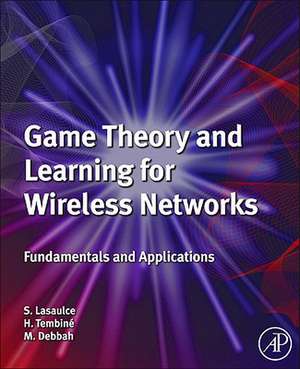Game Theory and Learning for Wireless Networks: Fundamentals and Applications
Autor Samson Lasaulce, Hamidou Tembineen Limba Engleză Hardback – 19 aug 2011
With the growth of distributed wireless networks such as Wi-Fi and the Internet; the push to develop ad hoc and cognitive networks has led to a considerable interest in applying game theory to wireless communication systems. Game Theory and Learning for Wireless Networks is the first comprehensive resource of its kind, and is ideal for wireless communications R&D engineers and graduate students.
Samson Lasaulce is a senior CNRS researcher at the Laboratory of Signals and Systems (LSS) at Supélec, Gif-sur-Yvette, France. He is also a part-time professor in the Department of Physics at École Polytechnique, Palaiseau, France.
Hamidou Tembine is a professor in the Department of Telecommunications at Supélec, Gif-sur-Yvette, France.
Merouane Debbah is a professor at Supélec, Gif-sur-Yvette, France. He is the holder of the Alcatel-Lucent chair in flexible radio since 2007.
- The first tutorial style book that gives all the relevant theory, at the right level of rigour, for the wireless communications engineer
- Bridges the gap between theory and practice by giving examples and case studies showing how game theory can solve real world resource allocation problems
- Contains algorithms and techniques to implement game theory in wireless terminals
Preț: 441.41 lei
Preț vechi: 564.90 lei
-22% Nou
Puncte Express: 662
Preț estimativ în valută:
84.47€ • 88.08$ • 70.21£
84.47€ • 88.08$ • 70.21£
Carte tipărită la comandă
Livrare economică 14-28 martie
Preluare comenzi: 021 569.72.76
Specificații
ISBN-13: 9780123846983
ISBN-10: 0123846986
Pagini: 336
Ilustrații: Approx. 200 illustrations
Dimensiuni: 191 x 235 x 18 mm
Greutate: 0.79 kg
Editura: ELSEVIER SCIENCE
ISBN-10: 0123846986
Pagini: 336
Ilustrații: Approx. 200 illustrations
Dimensiuni: 191 x 235 x 18 mm
Greutate: 0.79 kg
Editura: ELSEVIER SCIENCE
Public țintă
University researchers and R&D engineers in the industry, graduate and PhD students in wireless communicationsCuprins
Preface and Introduction.
Part A Games with Complete Information
A1 A short tour of game theory
A2 Playing with equilibria in wireless non-cooperative games
A3 Moving from static to dynamic game
A4 Coalitional games
Part B Games with complete information and learning
B1 Bayesian games
B2 Partially distributed learning algorithms
B3 Fully distributed learning algorithms
Part C Case Studies
C1 Fundamentals of wireless communications
C2 Energy-efficient power control games
C3 Rate-efficient power allocation games
C4 Medium access control games
Part D Appendices
Bibliography and index
Part A Games with Complete Information
A1 A short tour of game theory
A2 Playing with equilibria in wireless non-cooperative games
A3 Moving from static to dynamic game
A4 Coalitional games
Part B Games with complete information and learning
B1 Bayesian games
B2 Partially distributed learning algorithms
B3 Fully distributed learning algorithms
Part C Case Studies
C1 Fundamentals of wireless communications
C2 Energy-efficient power control games
C3 Rate-efficient power allocation games
C4 Medium access control games
Part D Appendices
Bibliography and index
